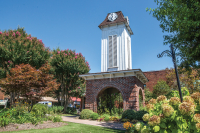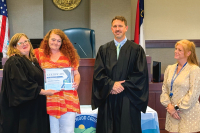Finding a WNC solution for ‘aging in place’
With so many unknowns ahead, it’s comforting there are proven solutions to one big challenge — the aging of the population. From research, and experience, experts have identified factors for remaining independent, resilient and happy as we grow older. Key among them: nutritious meals; regular exercise; and the opportunity to engage meaningfully with friends and with the broader community.
Obvious, right? So it should be easy to integrate those components into programs and policies. Except for the fact that we’ve organized American life to make them tough to implement at any age.
We’ve grown fat on processed food and little exercise. We’ve abandoned the oldest traditions of community life in villages and towns and sprawled into the countryside. The move has isolated us from one another and exiled us to hours in automobiles commuting to every aspect of our daily lives. As a result, when we get older, we’re often stuck with habits that threaten our health and with environments that inhibit mobility and opportunities for maintaining the connections we need to avoid hospitals and nursing homes.
Demographics and economics are forcing us to take the problem seriously. Between 2000 and 2050, the U.S. population is expected to grow by 48 percent. Over the same period, the demographic category of folks aged 65 to 84 is expected to grow by 114 percent; and the percentage growth of the 85-plus group is projected at 389 percent. In North Carolina, by 2029, 17.2 percent of the population is expected to be 65 or older, compared to 12.2 percent in 2008.
Public agencies and nonprofits at all levels want to ramp up to meet the challenge. But the gap between demand and funding support is huge and getting huger, first because of the sheer numbers, and now because of the economic downturn. So it’s time for individuals and communities to start thinking of do-it-yourself strategies that build on what works for a growing senior population.
For policymakers, the most senior-friendly strategy is to help villages and towns renew walkable, mixed-use neighborhoods with diverse housing choices that serve people of all ages. For those of us who plan to get old, it’s time to take charge of this stage of our lives. If we want the infrastructure, emergency services, and amenities of in-town living, let’s build or redevelop neighborhoods in towns instead of insisting developers and county governments deliver town-like services in remote places.
Related Items
For those with a gift for organization, there’s a growing movement of senior “co-housing” in which potential neighbors come together before there’s a physical neighborhood. They decide on elements of the environment they want, then hire design and construction teams to build it. Cohousing neighborhoods already exist in Asheville and throughout North Carolina. New groups are forming all the time. The idea aligns perfectly with what is already a strong desire for more alternatives for town living and with innovative developers’ projects that tap into the best tradition of compact, connected neighborhoods.
(Ben Brown is a Franklin-based writer and communications consultant who works with private sector clients and governments on Smart Growth planning. He can be reached at This email address is being protected from spambots. You need JavaScript enabled to view it..)









